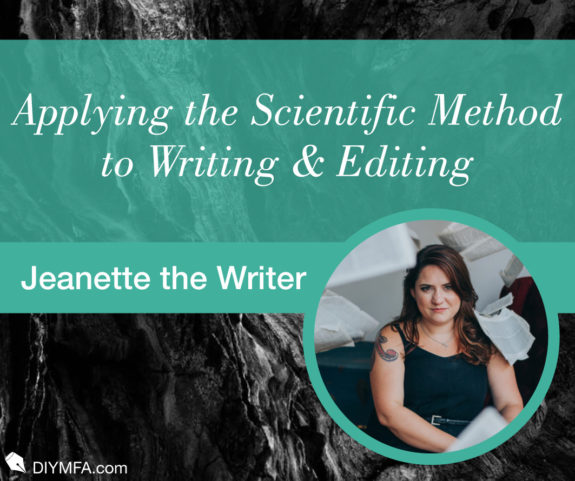In grade school, my sister won our science fair with a project about putting sponges in the dishwasher to kill bacteria. She had a good hypothesis, ran a solid experiment, and had lots of imagery on her presentation board. She had very clearly (and successfully) applied the scientific method.
I like to break the scientific method into these steps: asking a question, performing research, establishing a hypothesis, conducting an experiment, making an observation, analyzing the results, and publishing the findings. When we look at the writing and editing processes, we see the same steps are necessary to get our words out into the world.
Here’s how it breaks down…
Ask a Question
For writers, this question is usually “what if?” What if dragons were real? What if I could write a love note disguised as a grocery list? What if this amazing thing were to happen to this ordinary person? What if… You get the idea. Our question is essentially our idea however fully formed or half-baked it might be.
Perform Research
This is the step where we make sure no one has run our exact experiment before. This is a great stage to start looking for comps. For novels, we must make sure our premise is different enough from other authors’ ideas, but still speaks to what’s hot on the market. For short stories, we might start exploring different journals that would fit the vibe of the piece we want to write.
The other purpose of research is to prep ourselves for what we’re about to do. Want to write a romance? Read in the genre. Want to write short stories? Read literary magazines. Want to try a literary style you’ve never used before? Read a craft book or article on how to do it. Reading is the equivalent of doing research for our writing ideas.
Establish Your Hypothesis
A hypothesis is an educated guess of what we think the outcome will be. In science, it’s usually a sentence or two. In writing, this is the step where we write our whole first draft. We’re putting down what we think are the right words to get across our ideas in the way we imagine. We’re starting with “once upon a time” and closing with “the end” and not judging (yet) any of the words in between. Further investigation is needed before we start evaluating whether our hypothesis was right.
Conduct an Experiment
Yay—the editing portion of the scientific method! Editing is like conducting an experiment. First, we have our control group (first draft). Now, we apply our experimental process to similar groups (aka copied drafts).
At first, we may be looking for any type of result. We may be making wild changes to our experimental drafts—cutting out characters, inserting themes, rearranging sections—just to see what the results will be. Once we see what we’re working with, then we can experiment like Gregor Mendel, breeding our pea pods (words) together in new ways to see if we can reach perfection.
In seeking perfection, remember to only change one type of variable at a time. Start with the big variables like character development and world-building before moving on to another draft where we’ll work with more detailed variables such as word choice and punctuation. We would never conduct an experiment with a limited number of people or just one group, so don’t be afraid to revise multiple times and try different structures, tones, voices, or POVs each time.
Experiments are messy by design. They are a time to play around without judging the results quite yet. Even Mendel had to leave time for his pea pods to sprout. At the end of our experiment, we should put away our drafts for a time (you decide how long) before coming back to evaluate.
Make an Observation
Now, it’s time to step back and see what happened with our experiments. In a real science experiment, we would make rational and objective observations and record them. Since we are often too close to our own written works, even after leaving time between evaluation and experiment, it‘s best to leave this step to an outside party when writing.
Find a trusted critique partner, writing group, or editor to help assess the results of the experiment. Ask for written feedback on what works in each draft or take notes during a verbal critique. An evaluation from an editor can also help objectively record the results of our experiments.
Analyze the Results
Once we have written observations (critique) we must decide how to combine the results of our experiment into our final draft. As we analyze the results, we take the feedback presented by our writing partners or that we assessed ourselves and we look for trends and patterns. Did more than one person agree third person was the best POV for the piece? Do we have multiple comments about a particular sentence we know we should leave in? Understanding the results of our writing is critical to getting it presentation ready.
Present the Findings
Here, we’re going to finalize our draft and polish it to a shine. This is the culmination of all our hard work. We created this beautiful experiment and saw how our original hypothesis blossomed into something new. It’s our duty to now share our findings with the world. In the final step of the scientific process, we must publish our work. Whether it’s querying and submitting or self-publishing, don’t skip this critical step.
There you have it—how to apply the scientific method to writing and editing.
Tell me: What do you compare the writing and editing processes to?

Jeanette the Writer is a freelance editor and writer based in Dallas, TX. When not at her computer, you can find her crafting, scuba diving, or posting pictures of her cats on Instagram. Visit JeanettetheWriter.com for more info and follow @JeanettetheWriter on Instagram and Facebook.







